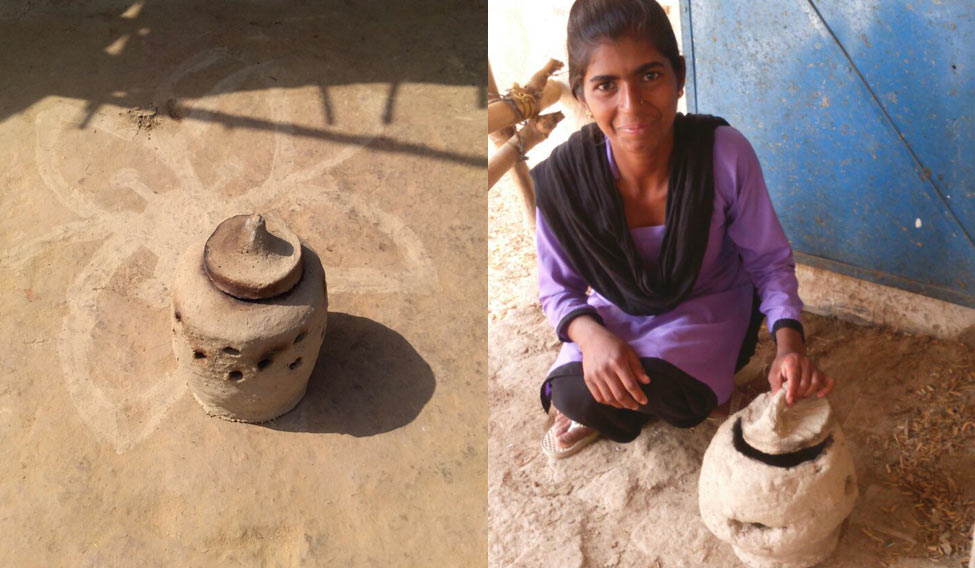Not many will dispute that village folk, for lack of education, need to learn civic sense and concepts of hygiene from their urban counterparts. However, this may not be the case always.
Not convinced? Well, answer this. Do you have an incinerator to dispose of menstrual waste generated by the women in your family? You may be an urban dweller, but most likely your answer would be a no.
But ask the same question to Gayatri, 19, from Lalpur village in Mohanlal Ganj Block of Lucknow, and she will proudly point at the incinerator she has at home for this purpose. And Gayatri is not a lone example. All households in her village have this indigenously developed incinerator to dispose menstrual waste.
Known as matka (earthen pitcher), this earthen incinerator has been specifically made for the purpose. It has a layer of soil and is lined with neem leaves. All menstruating females of that household discard their used sanitary pads in this matka and cover it with dried neem leaves. Once full, the waste is doused with some oil and set alight. The ash is then easily disposed.
“At least now, there is no nuisance,” tells Gayatri with a sense of relief. “Earlier, we would dispose of the used pads in the fields or ponds and stray dogs would sniff them out and strew the tattered pieces of blood soaked napkins and cloth all over the village. Disgusted at the sight of used napkins littered outside their homes, people would verbally abuse the women at large for being irresponsible and shameless,” rues Gayatri.
Echoing the views of this teenager, Krishna Devi, a local hygiene activist associated with Vatsalya— a public health organization, adds, “Until being declared an open defecation free (ODF) village, we faced a lot of problems. Disposal of sanitary pads would take place when women would go out for defecation. Used pads strewn in the fields exposed people to various infections, affecting the overall health of villagers. Stray animals only added to the mess. But this matka has changed the way women perceive menstruation.” Krishna continues, “Thanks to this matka, women no more find menstruation a burden. They have become more conscious about maintaining menstrual hygiene.”
Neelima Gupta, who led this initiative, representingVatsalya, in partnership with WaterAid, says, “We have introduced this practice in a couple of villages across Lucknow and the response has been very encouraging. Now, women in these villages are relatively more conscious about their health and hygiene. In fact improved hygiene has also improved the overall quality of life in these villages.”
Considering the relevance and simplicity of this innovation, one wonders why this is not replicated in a bigger geography. But Dr Neelam Singh, a gynaecologist and chief official of Vatsalya sounds hopeful. She says, “Officials from the State establishment of Swachh Bharat Mission have appreciated our initiative and are willing to replicate the model in other places. We are ready to join hands with them to scale this up and are in fact working out the possibilities. We expect great synergies in larger public interest.”
Appreciating the concept of this matka and reiterating the need for proper waste disposal to improve overall community health, Dr Skand Shukla, an immunologist and science communicator, says, “Ironically, there is a general disregard to the need and relevance of maintaining hygiene. To this, add the tabooed topic of menstrual hygiene and the situation becomes more complex. There is hardly any protocol followed by urban dwellers for disposal of this potentially hazardous waste. It may not be the best way, but considering the consciousness and limited resources these women have, this initiative needs to be applauded.”
According to a paper published in the British Medical Journal, it is estimated that roughly 9000 tonnes of menstrual waste is generated in India each month. This figure itself implies the need for proper menstrual waste disposal. This waste is largely disposed with household waste and is sadly sorted by bare-handed waste pickers, exposing them in particular and the community at large to several disease-causing micro-organisms.
So, the next time you look down upon a village woman for being backward, remember, she may make you may feel inadequate.
HEALTH
Menstrual waste disposal: UP village shows the way
 L-R: The earthen incinerator and Gayatri next to her earthen incinerator
L-R: The earthen incinerator and Gayatri next to her earthen incinerator
This browser settings will not support to add bookmarks programmatically. Please press Ctrl+D or change settings to bookmark this page.
THE WEEK
Select your subscription
Please select subscription.
Select payment method
Please select payment method.
Confirm your subscription
Recharge E-Wallet
Enter recharge amount:
Topics :
#lifestyle
| #health





